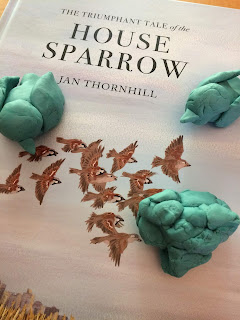By Jan Thornhill
Published April 1, 2018
Why we chose this book:
We received a bird feeder for Christmas and enjoy watching birds in the backyard. We love learning about nature. So when I saw this book about birds we see everywhere, I hoped it would be a good fit for us, and the publisher provided a review copy.
Mom's Review
Readers learn about the evolution of the house sparrow and its relationship to humans.
Visually appealing and informative The Triumphant Tale of the House Sparrow prompted much conversation over several sittings. This is intended for children in grades 4 through 7, and the vocabulary is appropriate to that age range. We read in small chunks (which was perfectly fine for the way the narrative is organized) and talked about what everything meant. I would strongly recommend this for children in the intended age range, especially if they are interested in nature or birds or the backyard bird feeder. I found the art beautiful and the narrative engaging; I enjoyed reading it and learning about the cute little birds that hop around our yard.
This is much more than just an explanation of the house sparrow's life cycle. The narrative (this really is a story, and T asked for confirmation that this was a true story a few times), explains how the sparrow has evolved from being considered a pest to being protected, its role in the ecosystem, and how it helps farmers. In ancient Egypt, house sparrows were already raiding crops, and that has not changed. Over time, vast extermination efforts have taken place in order to preserve crops; a successful effort initiated by Chairman Mao resulted in an overabundance of insects that ate more grain than the sparrows had. Following the events in China, other countries changed their approach to dealing with the bird. And, with our changing agriculture, the little bird's ability to feast on grain has changed, causing a recent decline in population. It is now protected in the Netherlands. I found some of the trivia quite fascinating, such as what the Egyptians did with the sparrows they caught and how many sparrows you need for a sparrow pie. Overall, I would say that I have a pretty good knowledge of the house sparrow, and T knows what it eats, where it lives, and why people don't like it sometimes. He is also super eager to set up our bird feeders at the new house!
Son's Questions and Comments
(age 3)
Mom: Would you want to share any of your grain with the house sparrow?
Son: Yes. I would give him oats.
Mom: Do you want to feed house sparrows in your back yard? Let's set up our bird feeder.
Son: I do. House sparrows will come.
___________________________
Son: Why do they have to keep the eggs warm?
Mom: To keep the babies inside the eggs warm so that they don't die. The babies can't stay warm themselves.
Son: Why do they need to sit on the eggs? I thought they just holded the eggs. They could use their wings.
Mom: That's how the keep the eggs warm because they don't have hands. They can't pick things up with their wings.
___________________________
Son, pointing to mummies: Are those the ancient Egyptians?
Mom: Those are mummies of falcons. The Egyptians made those.
___________________________
Mom: Would you want the job of sparrow catcher? What would you do if you caught one?
Son: Yes. I would sell it to the pet store.
Mom: To feed to the pets or be sold as pets?
Son: To be sold as a pet!
___________________________
Mom: Would you want to sit on a bench covered in sparrow poop?
Son: No.
Mom: I wouldn't either. What do you think they might do?
Son: Clean the bench. Lock them [the sparrows] up in cages.
___________________________
Mom: Do you think we should have sparrows or not have sparrows? Why?
Son: Should have sparrows. Because I like them and I think they look cute. Except when they're a baby one.
___________________________
___________________________
Mom: What was your favorite thing you learned about house sparrows?
Son: That they killed them.
Mom: Why did people kill them? What were the house sparrows doing that made people kill them?
Son: Eating their crops!
Mom: What do you think we should do about the house sparrows?
Son: I think we should keep them as pets.
Mom: How would you take care of the house sparrows?



Comments
Post a Comment